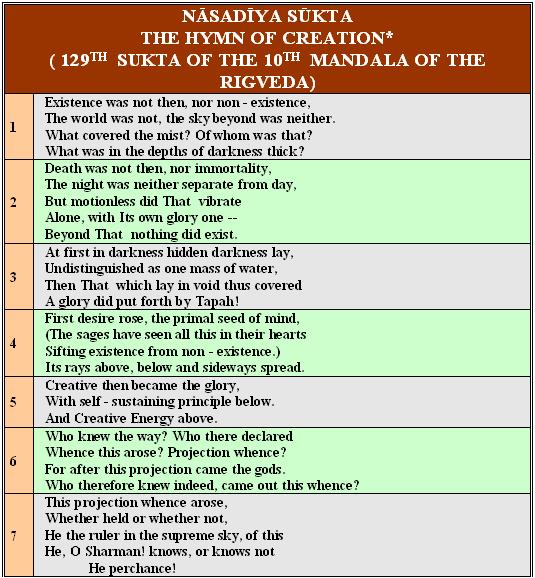This essay originally appeared in the May, 2000 issue of Tirumala Tirupati Devasthanams’ illustrated monthly ‘Sapthagiri’ which is now revised.
Introduction
One of the oldest pastimes of man is to run the search engine of his contemplative and analytical faculties to find out the final answer to the riddle of creation of the universe. This question is not merely academic but it also assumes the colors of religion, philosophy, science and poetry.
We have answers to this enigma in every religion. We have scientific theories throwing up endless ever changing conclusions. We have philosophers’ speculations and poetic imaginations. But the mystery of creation remains as much unfathomed and unsolved today as in the Vedic days.
Vedic Perspective on Creation
Creation is interpreted in the Vedas as a developmental course rather than as bringing into being something not hitherto existent. It was considered as a process and not an event. The Purusha Sukta paints a picture of the ideal primeval being existing before any phenomenal existence. He is conceived as a cosmic person with a thousand heads, eyes and feet, who filled the whole universe and extended beyond it. The world form is only a fragment of this divine reality.
The first principle which is called Purusha manifested as the whole world by his Tapas. This view gets crystallized into the later Upanishadic doctrine that the spirit or Atman in man (at microcosm) is the same as the spirit which is the cause of the world which goes by the name Brahman or Paramatman (at macrocosm).
The earliest and the most remarkable account of creation is to be found in the famous Naasadiya Sukta of Rig Veda. This verse explains the universe as evolving out of the one Absolute Reality which pervades and permeates the whole cosmos. But the One is not a god like Indra, Varuna, Prajapathi or Viswakarman. The hymn declares that all these gods are of a later origin and hence they know nothing of the beginning of things. A translation of this famous hymn by Swami Vivekananda is given below;

* The Complete Works of Swami Vivekananda - Volume 6 [Page: 178]
Hence the first principle, That One - tad ekam - cannot be characterized. It is without qualities or attributes, even negative ones. To apply to it any description is to limit the limitless. Yet after attempting to describe such a state presumed to be prior to creation the hymn has the humility to admit that all this is a surmise, for it is not possible to be sure of things which lie so far beyond human knowledge.
Sri Bhagavan Ramana Maharshi echoes more or less the same idea when he replies a devotee that the Srutis do not mean to set forth any theories of creation. He says that they mention such theories casually so that the enquirer may please himself if he be so inclined. According to him the truth is that the world appears as a passing shadow in a flood of light. Light is necessary to see the shadow also. But the shadow does not deserve any special notice or analysis.
Views of Upanishads on creation
Vedantic masters say that knowing the truth of creation is tantamount to knowing the truth of God. All their arguments and views to unravel the truth behind creation are based on the Upanishads. Their explanation of creation is subtle which can be fathomed only by a contemplative mind.
Sometime or the other man always thinks about certain fundamental puzzles of life viz. Who am I? Wherefrom I have come? Where do I go? What is the purpose of my coming? These questions do arise because when an effect is perceived, the intellect seeks to find out its cause.
Let us have a peek into some of the Upanishads on this point.
Many such questions were posed to a teacher by his students in the Prasna Upanishad making a direct enquiry into the phenomenon called the universe with a view to discover the ultimate cause for all the pluralistic existence. The answers given are the subject matter of this entire Upanishad.
Similar questions were answered by the master in Aitareya Upanishad. ‘In the beginning verily, Atman (Self) alone was this Universe.... nothing else whatsoever was active.’ The emphasis is on the words nothing else. As an individual can understand the world only with reference to himself, the Rishi says that before the creation of the pluralistic world all that existed was the Self or Atman of the seeker which is nothing but the All Pervading reality, Brahman.
This idea that the self alone existed, implies that the Supreme did not create the world of plurality out of some material cause just as a pot-maker makes his pots out of clay which is other than the potter himself. In the program of creation of the universe, the Supreme itself is both the raw material, which is termed as material cause as well as the blue collar worker which is named as the efficient cause.
This is explained in the Mundakopanishad: ‘As a spider projects and withdraws into itself the web, as the plants sprout from the earth, as hair grows on the head and body of man, so from the Imperishable comes out the Universe’.
This Mantra gives us three ideas to grasp the creative process.
| 1 |
Out of the Supreme the world has come without the intervention of any cause other than Himself and in the end the projected world gets absorbed back again into the Divine. |
| 2 |
The Supreme neither exerts the effort nor the purpose in the process of creation. Creation is an effortless, purposeless projection, a Divine Leela or play and |
| 3 |
The Supreme is not a dead inert matter like a sunless void or an irreversible emptiness. It is an active, positive, conscious and vital personality, an All Pervading Essence which goes by the description Sat-Chit-Ananda (Existence Absolute, Knowledge Absolute and Bliss Absolute). |